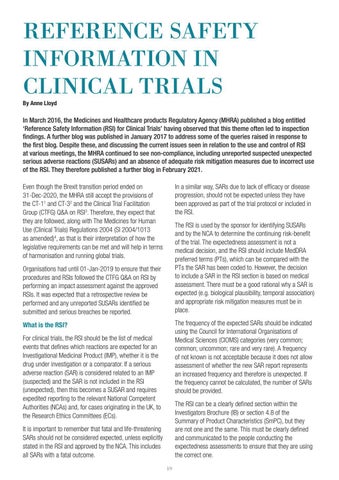REFERENCE SAFETY INFORMATION IN CLINICAL TRIALS By Anne Lloyd
In March 2016, the Medicines and Healthcare products Regulatory Agency (MHRA) published a blog entitled ‘Reference Safety Information (RSI) for Clinical Trials’ having observed that this theme often led to inspection findings. A further blog was published in January 2017 to address some of the queries raised in response to the first blog. Despite these, and discussing the current issues seen in relation to the use and control of RSI at various meetings, the MHRA continued to see non-compliance, including unreported suspected unexpected serious adverse reactions (SUSARs) and an absence of adequate risk mitigation measures due to incorrect use of the RSI. They therefore published a further blog in February 2021. Even though the Brexit transition period ended on 31-Dec-2020, the MHRA still accept the provisions of the CT-11 and CT-32 and the Clinical Trial Facilitation Group (CTFG) Q&A on RSI3. Therefore, they expect that they are followed, along with The Medicines for Human Use (Clinical Trials) Regulations 2004 (SI 2004/1013 as amended)4, as that is their interpretation of how the legislative requirements can be met and will help in terms of harmonisation and running global trials.
In a similar way, SARs due to lack of efficacy or disease progression, should not be expected unless they have been approved as part of the trial protocol or included in the RSI. The RSI is used by the sponsor for identifying SUSARs and by the NCA to determine the continuing risk-benefit of the trial. The expectedness assessment is not a medical decision, and the RSI should include MedDRA preferred terms (PTs), which can be compared with the PTs the SAR has been coded to. However, the decision to include a SAR in the RSI section is based on medical assessment. There must be a good rational why a SAR is expected (e.g. biological plausibility, temporal association) and appropriate risk mitigation measures must be in place.
Organisations had until 01-Jan-2019 to ensure that their procedures and RSIs followed the CTFG Q&A on RSI by performing an impact assessment against the approved RSIs. It was expected that a retrospective review be performed and any unreported SUSARs identified be submitted and serious breaches be reported.
The frequency of the expected SARs should be indicated using the Council for International Organisations of Medical Sciences (CIOMS) categories (very common; common; uncommon; rare and very rare). A frequency of not known is not acceptable because it does not allow assessment of whether the new SAR report represents an increased frequency and therefore is unexpected. If the frequency cannot be calculated, the number of SARs should be provided.
What is the RSI? For clinical trials, the RSI should be the list of medical events that defines which reactions are expected for an Investigational Medicinal Product (IMP), whether it is the drug under investigation or a comparator. If a serious adverse reaction (SAR) is considered related to an IMP (suspected) and the SAR is not included in the RSI (unexpected), then this becomes a SUSAR and requires expedited reporting to the relevant National Competent Authorities (NCAs) and, for cases originating in the UK, to the Research Ethics Committees (ECs).
The RSI can be a clearly defined section within the Investigators Brochure (IB) or section 4.8 of the Summary of Product Characteristics (SmPC), but they are not one and the same. This must be clearly defined and communicated to the people conducting the expectedness assessments to ensure that they are using the correct one.
It is important to remember that fatal and life-threatening SARs should not be considered expected, unless explicitly stated in the RSI and approved by the NCA. This includes all SARs with a fatal outcome. 19













